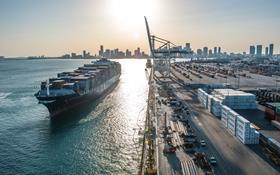
As the closest US port to many growing regions in Latin America, the port has a distinct advantage over its US rivals when it comes to getting product to the market fast. Jeff Long talks to manager for trade development and overseas trade Eric Olafson about the recent progress the port has made in attracting key trades.
ThePort of Miamireceived USDA approval to participate in the cold treatment pilot programme for imports certain fruits from South America in 2013. How have the first few years of the programme gone?
Eric Olafson: Since the pilot’s inception, PortMiami has had steady growth in the importation of citrus, grapes, and blueberries directly from Peru to PortMiami. We have recently received permission to bring cold treated apples and pears from Argentina and grapes and blueberries from Uruguay. There is keen interest in expanding trade routes directly to Florida as this is a key market for fresh fruit due to the 19m residents as well as the 105m people who visit the area every year.
How long had the port been working with US agricultural authorities for inclusion in the programme?
EO: For over five years. We have worked with the USDA, travelled with our federal partners to Peru to meet growers and shippers, and then ultimately developed new safe, secure and redundant cold treatment protocols – that have helped us open new markets in South America.
What advantages does thePort of Miamioffer importers of Latin American fresh fruits and vegetables over competing east coast ports?
EO: PortMiami is the closest port to the growing regions in Central America and South America, thus we can get product to market faster.We work with CBP for the prioritisation at perishables at PortMiami – thus preserving the cold chain. We also have more USDA staff than any other port of entry, which has given authorisation for on/off port fumigation of 5,000 pallets per day.In addition, PortMiami has 3,000 on-site reefer plugs and state-of-the-art coldstorage warehousing within 20-30 minutes of the port. There is also 228m square feet of warehouse space in Miami-Dade County within 20-40 minutes of our port, 10 per cent of which is refrigerated.
Do you feel the Port's distribution radius will be limited to the southeast or is there potential for servicing major metropolitan markets around the country?
EO: We don’t have many limits for growth, as the PortMiami route saves time to market, increases shelf life, reduces carbon footprint-quickest delivery to Southeast. With multiple carriers with the most frequent service to the Caribbean, Central and South America we think PortMiami will remain the preferred perishables gateway. We are the undisputed “Gateway of the Americas”; in fact we have trademarked the name!






No comments yet